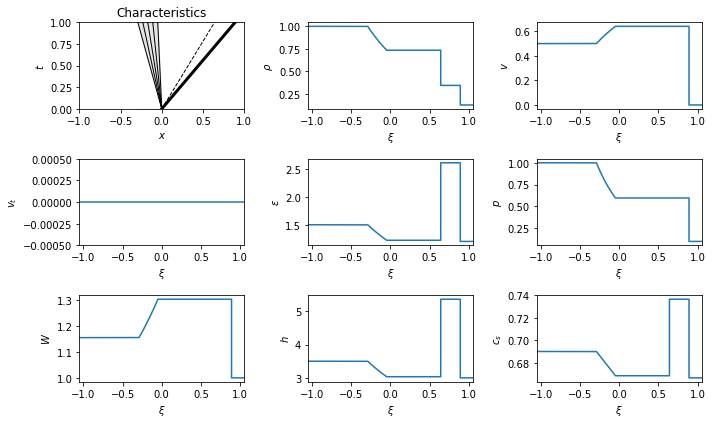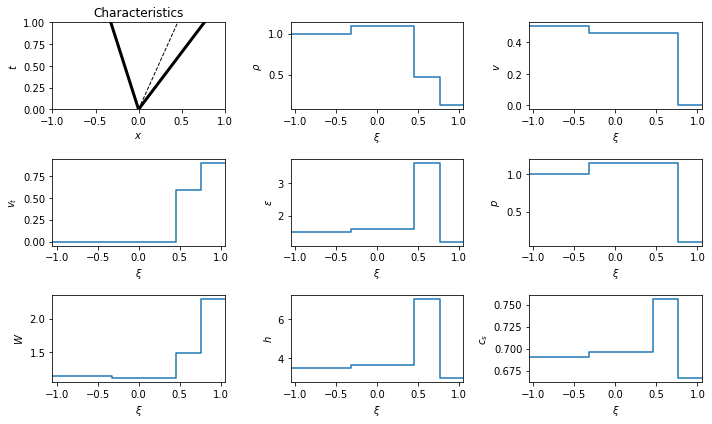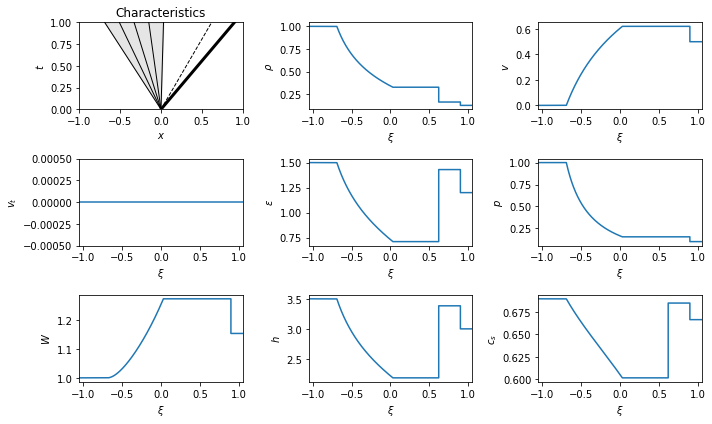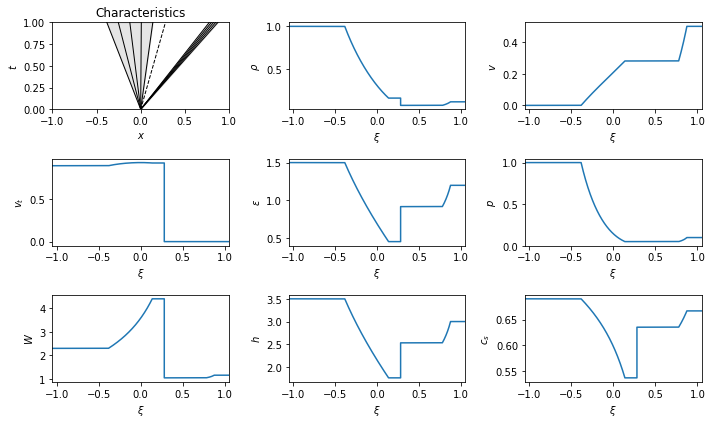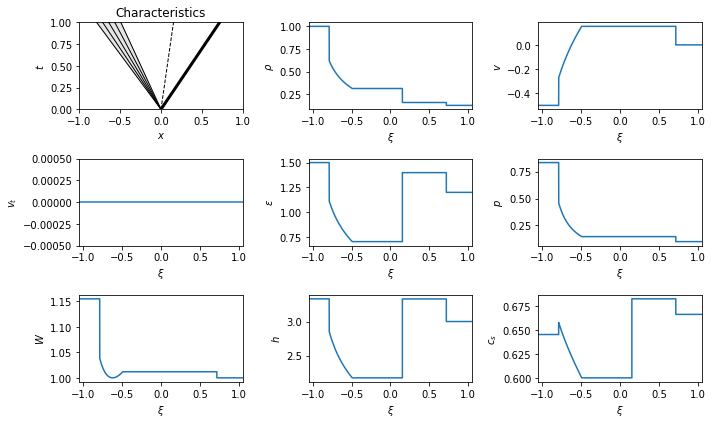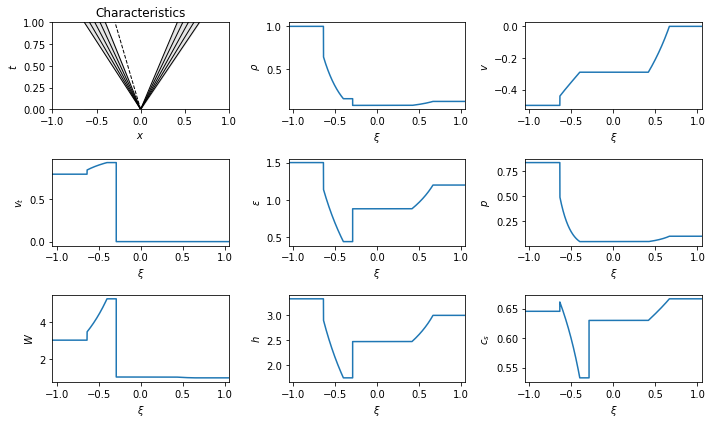The effect of tangential velocities
It was first noted by Rezzolla, Zanotti and
Pons that there is one
effect that is specific to relativistic Riemann problems. Thanks to
the Lorentz factor coupling the tangential velocities more tightly to
the other terms, it is possible to change the wave pattern in the
problem solely by changing the tangential velocity. This cannot happen
in the Newtonian case.
The examples used in their paper use a modified relativistic Sod
problem as a base. We set that problem up first:
\begin{equation}\begin{cases} \begin{pmatrix} \rho \\ v_x \\ v_t \\ \epsilon \end{pmatrix}= \begin{pmatrix} 1.0000 \\ 0.5000 \\ 0.0000 \\ 1.5000 \end{pmatrix},\\ \begin{pmatrix} \rho \\ v_x \\ v_t \\ \epsilon \end{pmatrix}= \begin{pmatrix} 0.1250 \\ 0.0000 \\ 0.0000 \\ 1.2000 \end{pmatrix}, \end{cases} \quad \implies \quad {\cal R}_{\leftarrow}{\cal C}{\cal S}_{\rightarrow}, \quad p_* = 0.5974, \quad\begin{cases} {\cal R}_{\leftarrow}: \lambda^{(0)}\in [-0.2902, -0.0488],\\ {\cal C}: \lambda^{(1)}= 0.6407,\\ {\cal S}_{\rightarrow}: \lambda^{(2)}= 0.8900, \end{cases} \quad \begin{cases} \begin{pmatrix} \rho \\ v_x \\ v_t \\ \epsilon \end{pmatrix}_{\star_L} = \begin{pmatrix} 0.7341 \\ 0.6407 \\ 0.0000 \\ 1.2207 \end{pmatrix},\\ \begin{pmatrix} \rho \\ v_x \\ v_t \\ \epsilon \end{pmatrix}_{\star_R} = \begin{pmatrix} 0.3427 \\ 0.6407 \\ 0.0000 \\ 2.6154 \end{pmatrix}. \end{cases}\end{equation}
We see the wave pattern has a left going rarefaction and a right going
shock.
Now, by modifying the tangential velocity of the right state, the wave
pattern changes:
\begin{equation}\begin{cases} \begin{pmatrix} \rho \\ v_x \\ v_t \\ \epsilon \end{pmatrix}= \begin{pmatrix} 1.0000 \\ 0.5000 \\ 0.0000 \\ 1.5000 \end{pmatrix},\\ \begin{pmatrix} \rho \\ v_x \\ v_t \\ \epsilon \end{pmatrix}= \begin{pmatrix} 0.1250 \\ 0.0000 \\ 0.9000 \\ 1.2000 \end{pmatrix}, \end{cases} \quad \implies \quad {\cal S}_{\leftarrow}{\cal C}{\cal S}_{\rightarrow}, \quad p_* = 1.1509, \quad\begin{cases} {\cal S}_{\leftarrow}: \lambda^{(0)}= -0.3224,\\ {\cal C}: \lambda^{(1)}= 0.4549,\\ {\cal S}_{\rightarrow}: \lambda^{(2)}= 0.7638, \end{cases} \quad \begin{cases} \begin{pmatrix} \rho \\ v_x \\ v_t \\ \epsilon \end{pmatrix}_{\star_L} = \begin{pmatrix} 1.0879 \\ 0.4549 \\ 0.0000 \\ 1.5868 \end{pmatrix},\\ \begin{pmatrix} \rho \\ v_x \\ v_t \\ \epsilon \end{pmatrix}_{\star_R} = \begin{pmatrix} 0.4748 \\ 0.4549 \\ 0.5873 \\ 3.6363 \end{pmatrix}. \end{cases}\end{equation}
The result is a left going shock, rather than a rarefaction.
A shock-rarefaction problem can be modified, via a tangential velocity,
to a two rarefaction problem in a similar fashion:
\begin{equation}\begin{cases} \begin{pmatrix} \rho \\ v_x \\ v_t \\ \epsilon \end{pmatrix}= \begin{pmatrix} 1.0000 \\ 0.0000 \\ 0.0000 \\ 1.5000 \end{pmatrix},\\ \begin{pmatrix} \rho \\ v_x \\ v_t \\ \epsilon \end{pmatrix}= \begin{pmatrix} 0.1250 \\ 0.5000 \\ 0.0000 \\ 1.2000 \end{pmatrix}, \end{cases} \quad \implies \quad {\cal R}_{\leftarrow}{\cal C}{\cal S}_{\rightarrow}, \quad p_* = 0.1546, \quad\begin{cases} {\cal R}_{\leftarrow}: \lambda^{(0)}\in [-0.6901, 0.0309],\\ {\cal C}: \lambda^{(1)}= 0.6206,\\ {\cal S}_{\rightarrow}: \lambda^{(2)}= 0.8996, \end{cases} \quad \begin{cases} \begin{pmatrix} \rho \\ v_x \\ v_t \\ \epsilon \end{pmatrix}_{\star_L} = \begin{pmatrix} 0.3262 \\ 0.6206 \\ 0.0000 \\ 0.7108 \end{pmatrix},\\ \begin{pmatrix} \rho \\ v_x \\ v_t \\ \epsilon \end{pmatrix}_{\star_R} = \begin{pmatrix} 0.1621 \\ 0.6206 \\ 0.0000 \\ 1.4302 \end{pmatrix}. \end{cases}\end{equation}
And now with tangential velocity:
\begin{equation}\begin{cases} \begin{pmatrix} \rho \\ v_x \\ v_t \\ \epsilon \end{pmatrix}= \begin{pmatrix} 1.0000 \\ 0.0000 \\ 0.9000 \\ 1.5000 \end{pmatrix},\\ \begin{pmatrix} \rho \\ v_x \\ v_t \\ \epsilon \end{pmatrix}= \begin{pmatrix} 0.1250 \\ 0.5000 \\ 0.0000 \\ 1.2000 \end{pmatrix}, \end{cases} \quad \implies \quad {\cal R}_{\leftarrow}{\cal C}{\cal R}_{\rightarrow}, \quad p_* = 0.0513, \quad\begin{cases} {\cal R}_{\leftarrow}: \lambda^{(0)}\in [-0.3838, 0.1375],\\ {\cal C}: \lambda^{(1)}= 0.2809,\\ {\cal R}_{\rightarrow}: \lambda^{(2)}\in [0.7773, 0.8750], \end{cases} \quad \begin{cases} \begin{pmatrix} \rho \\ v_x \\ v_t \\ \epsilon \end{pmatrix}_{\star_L} = \begin{pmatrix} 0.1683 \\ 0.2809 \\ 0.9324 \\ 0.4573 \end{pmatrix},\\ \begin{pmatrix} \rho \\ v_x \\ v_t \\ \epsilon \end{pmatrix}_{\star_R} = \begin{pmatrix} 0.0838 \\ 0.2809 \\ 0.0000 \\ 0.9189 \end{pmatrix}. \end{cases}\end{equation}
Reactive case
An interesting question is on the potential impact of this relativistic
effect on detonations and deflagrations. Let us set up a reference
reactive problem and add tangential velocities:
\begin{equation}\begin{cases} \begin{pmatrix} \rho \\ v_x \\ v_t \\ \epsilon \\ q \end{pmatrix}= \begin{pmatrix} 1.0000 \\ -0.5000 \\ 0.0000 \\ 1.5000 \\ 0.2500 \end{pmatrix},\\ \begin{pmatrix} \rho \\ v_x \\ v_t \\ \epsilon \end{pmatrix}= \begin{pmatrix} 0.1250 \\ 0.0000 \\ 0.0000 \\ 1.2000 \end{pmatrix}, \end{cases} \quad \implies \quad \left({\cal CJDF}_{\leftarrow}{\cal R}_{\leftarrow}\right) {\cal C}{\cal S}_{\rightarrow}, \quad p_* = 0.1464, \quad\begin{cases} \left({\cal CJDF}_{\leftarrow}{\cal R}_{\leftarrow}\right) : \lambda^{(0)}\in [-0.7887, -0.4919],\\ {\cal C}: \lambda^{(1)}= 0.1532,\\ {\cal S}_{\rightarrow}: \lambda^{(2)}= 0.7187, \end{cases} \quad \begin{cases} \begin{pmatrix} \rho \\ v_x \\ v_t \\ \epsilon \end{pmatrix}_{\star_L} = \begin{pmatrix} 0.3120 \\ 0.1532 \\ 0.0000 \\ 0.7039 \end{pmatrix},\\ \begin{pmatrix} \rho \\ v_x \\ v_t \\ \epsilon \end{pmatrix}_{\star_R} = \begin{pmatrix} 0.1570 \\ 0.1532 \\ 0.0000 \\ 1.3989 \end{pmatrix}. \end{cases}\end{equation}
We see that this is a deflagration-shock problem.
Now add tangential velocities to the unburnt material:
\begin{equation}\begin{cases} \begin{pmatrix} \rho \\ v_x \\ v_t \\ \epsilon \\ q \end{pmatrix}= \begin{pmatrix} 1.0000 \\ -0.5000 \\ 0.8000 \\ 1.5000 \\ 0.2500 \end{pmatrix},\\ \begin{pmatrix} \rho \\ v_x \\ v_t \\ \epsilon \end{pmatrix}= \begin{pmatrix} 0.1250 \\ 0.0000 \\ 0.0000 \\ 1.2000 \end{pmatrix}, \end{cases} \quad \implies \quad \left({\cal CJDF}_{\leftarrow}{\cal R}_{\leftarrow}\right) {\cal C}{\cal R}_{\rightarrow}, \quad p_* = 0.0464, \quad\begin{cases} \left({\cal CJDF}_{\leftarrow}{\cal R}_{\leftarrow}\right) : \lambda^{(0)}\in [-0.6382, -0.4005],\\ {\cal C}: \lambda^{(1)}= -0.2901,\\ {\cal R}_{\rightarrow}: \lambda^{(2)}\in [0.4159, 0.6667], \end{cases} \quad \begin{cases} \begin{pmatrix} \rho \\ v_x \\ v_t \\ \epsilon \end{pmatrix}_{\star_L} = \begin{pmatrix} 0.1567 \\ -0.2901 \\ 0.9377 \\ 0.4445 \end{pmatrix},\\ \begin{pmatrix} \rho \\ v_x \\ v_t \\ \epsilon \end{pmatrix}_{\star_R} = \begin{pmatrix} 0.0789 \\ -0.2901 \\ 0.0000 \\ 0.8828 \end{pmatrix}. \end{cases}\end{equation}
Again, by adding tangential velocities to the right state the shock has
become a rarefaction.
